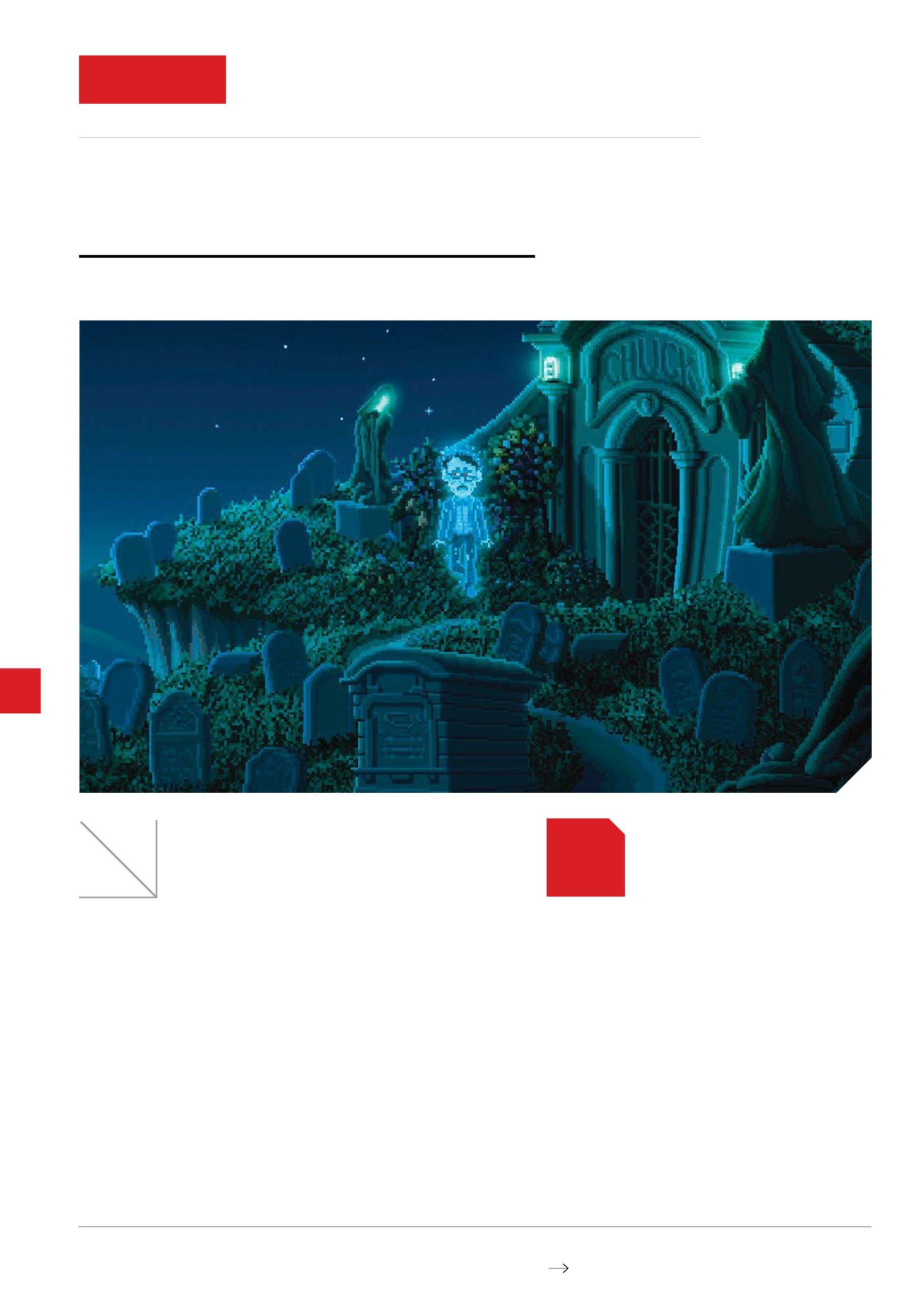
5 minute read
ThimBLeweed pArK
It’s no coincidence that Thimbleweed Park is set in 1987 - that’s the same year that Maniac Mansion came out
Publisher TerrIble Toybox / develoPer TerrIble Toybox / format xbox one / release date ouT now/ cost £16.74
How to review a point-and-click game? Use ‘fingers’ on ‘keyboard’ robert douglas
This game is more important than its humble pixels might imply. Back in the late ’80s and early ’90s, point-and-click adventures were making waves. In an industry just about coming to terms with plumbers doing a jump, we were seeing games like Monkey Island and Maniac Mansion put excellent writing and logic puzzles front and centre.
Now, though, Thimbleweed Park has a task on its 8-bit hands, looking to reinvigorate the genre for a new realm of gamers while meeting the expectations of Rob Gilbert’s fans. It begins with a murder. Two agents, the young and eager Reyes and the acerbic Ray, stand over a bludgeoned corpse. Interactions in this game are tied to words, as you gather inventory items and combine them with your surroundings by way of a collection of verbs in order to solve puzzles.
Reyes and Ray head out into the nearby town of Thimbleweed Park, population 80, to find out who’s responsible for the homicide and why. On the way you discover another three playable characters, each unlocked by playing through their back stories. These characters are the backbone of everything good in Thimbleweed Park. Half of the fun to be had here is in darting about town and finding how different NPC characters respond to your player character. Having Ransome, a sweary clown who suffers from a curse that inhibits him from removing his makeup, hurl insults at the local café proprietor, when other characters might politely natter away, is the stuff distractions are made of.
These characters are brought to life via an instantly iconic pixelated style which is no-frills enough to leave some nuance of the on-screen action to your imagination, but vibrant and intricate enough to be charming. Just watch how each character goes through a different throwing up animation after scoffing a mouldy hotdog and you’ll see what we mean.
short cut
What is it?
A point-and-click adventure evoking the spirit of games from 1987 to 1993.
What’s it like?
As if the last three decades of gaming never happened. Who’s it for?
If the words ‘three-headed monkey’ mean anything to you, then: you.
Moan of arc
One criticism we’d level at the characters is that, while they’re funny enough to have you chuckling throughout, only one of them really feels like he goes through any kind of actual arc. For the most part, these characters are the same people at the end of the game as they were at the beginning, so there’s little sense in taking them on a journey.
Also, while they interact with the town and its citizens constantly, there’s this weird gamey disconnect between them, which by necessity sees them barely interact with each other. A few more incidental lines of dialogue between, for example, the sarcastic Ray and the energetic
rigHt this is a weird game, and its humour can often feel too focused on genre easter eggs.
left by the time you’re done, the fourth wall will need some serious counselling.

and enthusiastic Delores (who in a knowing chortle-inducing nod is a point-and-click game developer), would have worked wonders. As it is, having these characters interact to solve puzzles, sharing knowledge across vast distances and giving each other items for no discernible narrative reason feels awkward.
Point and twist
Which brings us to the stonking great narrative twist that lies deep within Thimbleweed Park’s belly. It’s a doozy, and one that provides a retrospective excuse for pretty much any narrativebased critique you might care to fling at the game. It’s the kind of twist that is a satisfying pay-off when it happens, but as time passes and the end credits roll to a stop it’s easy to feel hard-done by. What starts as a murder mystery eventually becomes… something else, and while it all makes sense as it’s happening, those looking for an intriguing whodunit will leave utterly disappointed. With belly ache from laughing, yes, but also the feeling of being unfulfilled.
The same can’t be said of the puzzles. These are some of the finest ‘use thing on another thing’ conundrums that we – point-andclicking veterans that we are – have encountered. The verb system should feel archaic, but somehow, with a combination of shortcut controls and much, much clearer environments to scour, they don’t. There’s a huge difference between the game’s two modes, Casual and Hardcore, and it’s very obvious that the latter is the way the game was intended to be played. Those only here for the story and not craving an intense bout of head scratching can cruise right through the former, but they’ll miss out on some crucially brilliant teasers. Gilbert is a master of the ‘Aha!’ moment, and Hardcore mode is six to ten hours
PIxel hunTer
you shouldn’t ever have to resort to the age-old tactic of using all your inventory items on everything you can see in order to solve a puzzle. everything feels logical, and the game is incredibly adept at ushering your train of thought down certain tracks in order to prime you for possible solutions. There was only one instance of actual pixel hunting during our playthrough. To save you the effort: check the popcorn cart carefully… That’s all we’ll say. you’re welcome. jam-packed with those. Casual, by comparison, feels very cut down.
Although the genre is associated with a bygone era, Thimbleweed Park could herald a new age of awesome point-and-clicks, and shows that the old tricks can still work with a modern touch. Not everyone will appreciate its narrow comedic lens, but those who do will nurse aching sides even as they scoff at the twists and hope for a more satisfying narrative next time round. n
oXm verdict
Perfectly evokes the brilliant pointand-clicks of old, from the puzzles to the one-liners.
8












